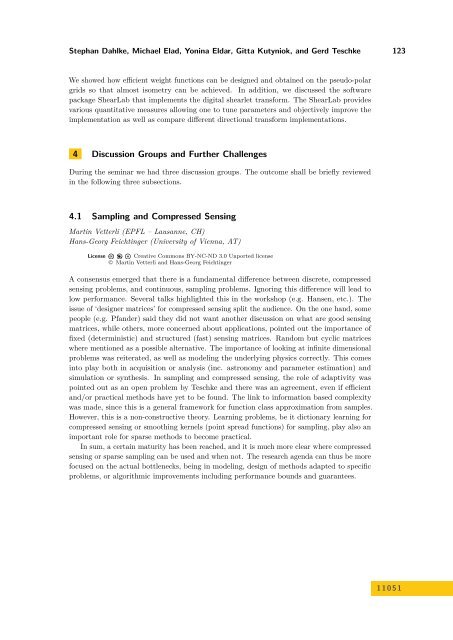Volume 1, Issue 1, January 2011 - DROPS - Schloss Dagstuhl
Volume 1, Issue 1, January 2011 - DROPS - Schloss Dagstuhl
Volume 1, Issue 1, January 2011 - DROPS - Schloss Dagstuhl
You also want an ePaper? Increase the reach of your titles
YUMPU automatically turns print PDFs into web optimized ePapers that Google loves.
Stephan Dahlke, Michael Elad, Yonina Eldar, Gitta Kutyniok, and Gerd Teschke 123<br />
We showed how efficient weight functions can be designed and obtained on the pseudo-polar<br />
grids so that almost isometry can be achieved. In addition, we discussed the software<br />
package ShearLab that implements the digital shearlet transform. The ShearLab provides<br />
various quantitative measures allowing one to tune parameters and objectively improve the<br />
implementation as well as compare different directional transform implementations.<br />
4 Discussion Groups and Further Challenges<br />
During the seminar we had three discussion groups. The outcome shall be briefly reviewed<br />
in the following three subsections.<br />
4.1 Sampling and Compressed Sensing<br />
Martin Vetterli (EPFL – Lausanne, CH)<br />
Hans-Georg Feichtinger (University of Vienna, AT)<br />
License Creative Commons BY-NC-ND 3.0 Unported license<br />
© Martin Vetterli and Hans-Georg Feichtinger<br />
A consensus emerged that there is a fundamental difference between discrete, compressed<br />
sensing problems, and continuous, sampling problems. Ignoring this difference will lead to<br />
low performance. Several talks highlighted this in the workshop (e.g. Hansen, etc.). The<br />
issue of ‘designer matrices’ for compressed sensing split the audience. On the one hand, some<br />
people (e.g. Pfander) said they did not want another discussion on what are good sensing<br />
matrices, while others, more concerned about applications, pointed out the importance of<br />
fixed (deterministic) and structured (fast) sensing matrices. Random but cyclic matrices<br />
where mentioned as a possible alternative. The importance of looking at infinite dimensional<br />
problems was reiterated, as well as modeling the underlying physics correctly. This comes<br />
into play both in acquisition or analysis (inc. astronomy and parameter estimation) and<br />
simulation or synthesis. In sampling and compressed sensing, the role of adaptivity was<br />
pointed out as an open problem by Teschke and there was an agreement, even if efficient<br />
and/or practical methods have yet to be found. The link to information based complexity<br />
was made, since this is a general framework for function class approximation from samples.<br />
However, this is a non-constructive theory. Learning problems, be it dictionary learning for<br />
compressed sensing or smoothing kernels (point spread functions) for sampling, play also an<br />
important role for sparse methods to become practical.<br />
In sum, a certain maturity has been reached, and it is much more clear where compressed<br />
sensing or sparse sampling can be used and when not. The research agenda can thus be more<br />
focused on the actual bottlenecks, being in modeling, design of methods adapted to specific<br />
problems, or algorithmic improvements including performance bounds and guarantees.<br />
1 1 0 5 1













